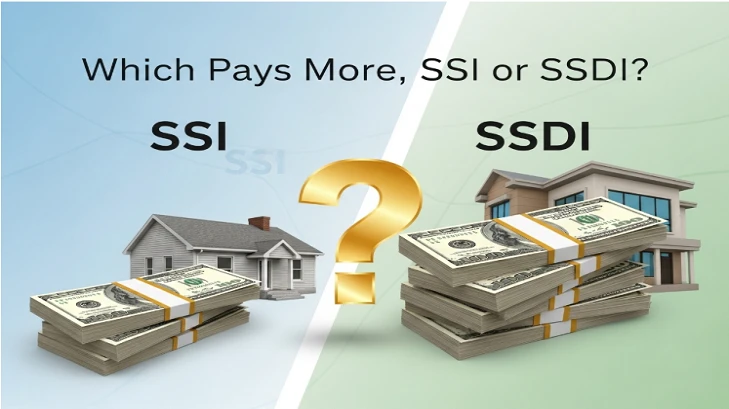- Author: Michael Burry
- Jul 16, 2025
Social Security Disability Insurance (SSDI) pays more in comparison to Social Security Insurance (SSI) for most people. However, both disability programs provide benefits to disabled claimants according to their needs.
When Can You Apply for SSDI and SSI?
The Social Security Administration (SSA) offers two programs for disabled people:
- Supplemental Security Income (SSI)
- Social Security Disability Insurance (SSDI)
People with low income and assets may apply for SSI benefits, whereas SSDI benefits are beneficial for those who have enough work credits and have worked for at least 10 years or more. Children with disabilities, adults above age 65, and people who haven’t worked can apply for SSI. Depending on the severity of an individual's condition, each Social Security Disability Benefit program may pay a different amount.
How Much Does Social Security Disability Pay in 2024?
Each year, inflation and cost-of-living adjustments rise, increasing the overall value of Social Security disability benefits.
- The maximum monthly payment for SSI is $943 in 2024 for an individual and $1,415 for a married couple.
- For SSDI, the maximum monthly benefits are $3,822 in 2024.

When Do You Receive SSI Payments?
The Social Security Administration (SSA) pays SSDI and SSI benefits at different times. If you are eligible for both disability benefits, you must find out when you will receive payments.
Every month, the SSI distributes its benefits on the first day. When the first of the month is a holiday or weekend, you get benefits the day before. You can receive your SSI payments in one of the following three ways:
- Through direct deposit
- You may receive it through a check in the mail
- Loaded onto a debit card
The Social Security Administration (SSA) will ask to wait until the fourth business day before contacting them about missing payments through mail.
When Do You Receive SSDI Payments?
People who are applying for the SSDI program have to wait until they receive the payment. There is an eligibility requirement that you need to meet: you have to be disabled for at least 5 months before you can apply. If the SSA approves your application for disability benefits, you will begin to receive benefits and payments six months after you have been struggling with disability.
For SSDI payments, the monthly date will vary depending on your birth date:
- For those who were born between the first and tenth of the month, you will receive SSDI benefits on each second Wednesday.
- For those who were born between the 11th and 20th of the month, you will receive SSDI benefits on the third Wednesday.
- For those who were born between the 21st and last day of the month, you will receive SSDI benefits on the fourth Wednesday.
You will receive your January benefits in February, meaning that each monthly payment will be for the previous month. If you receive both SSI and SSDI payments, you will receive them together on the third day of every month. If you're having trouble applying for disability benefits, a disability attorney can assist you with your appeal or claim process.
How Do You Calculate Your SSDI Benefits?
You can calculate your Social Security Disability Insurance benefit amount on your own or use a disability calculator to make an estimate. If you qualify for SSDI, it does not mean that the SSA will give you a check for a definite amount.
It depends on your historical earnings and SSA payments over your career. If you want to know your exact amount, you can create your mySocialSecurity account.
How Do You Calculate Your SSI Benefits?
If you earn any money with the SSI program, it will affect the amount of your check. This encompasses any earnings from your job and any passive income sources, including:
- State disability programs
- SSDI
- VA benefits
Suppose you don't have your own income and are living with someone who pays for your food and housing; that can lower the amount of your SSI check.
Monthly SSI benefit = Maximum SSI federal benefit rate ($943 in 2024) – Countable income.
The Average SSI and SSDI Payments Vary by State.
| State | Average Monthly SSI Benefit ($) |
|---|---|
| Alabama | 591.69 |
| Alaska | 575.77 |
| Arizona | 605.67 |
| Arkansas | 605.75 |
| California | 578.62 |
| Colorado | 594.10 |
| Connecticut | 608.91 |
| Delaware | 621.89 |
| District of Columbia | 637.52 |
| Florida | 598.21 |
| Georgia | 597.73 |
| Hawaii | 580.59 |
| Idaho | 598.36 |
| Illinois | 619.56 |
| Indiana | 615.55 |
| Iowa | 591.64 |
| Kansas | 602.02 |
| Kentucky | 603.50 |
| Louisiana | 611.54 |
| Maine | 585.11 |
| Maryland | 629.10 |
| Massachusetts | 604.27 |
| Michigan | 624.90 |
| Minnesota | 626.60 |
| Mississippi | 586.10 |
| Missouri | 593.27 |
| Montana | 569.33 |
| Nebraska | 586.18 |
| Nevada | 612.35 |
| New Hampshire | 577.42 |
| New Jersey | 575.60 |
| New Mexico | 580.32 |
| New York | 608.38 |
| North Carolina | 589.16 |
| North Dakota | 562.10 |
| Ohio | 625.24 |
| Oklahoma | 605.51 |
| Oregon | 610.13 |
| Pennsylvania | 631.22 |
| Rhode Island | 605.11 |
| South Carolina | 588.41 |
| South Dakota | 577.78 |
| Tennessee | 599.07 |
| Texas | 583.16 |
| Utah | 599.43 |
| Vermont | 583.56 |
| Virginia | 602.22 |
| Washington | 624.52 |
| West Virginia | 610.45 |
| Wisconsin | 613.05 |
| Wyoming | 582.19 |
| State | Average Monthly SSDI Benefit ($) |
|---|---|
| Alabama | 1,454.98 |
| Alaska | 1,473.09 |
| Arizona | 1,542.92 |
| Arkansas | 1,415.43 |
| California | 1,524.99 |
| Colorado | 1,497.71 |
| Connecticut | 1,549.41 |
| Delaware | 1,599.97 |
| District of Columbia | 1,321.04 |
| Florida | 1,521.74 |
| Georgia | 1,485.38 |
| Hawaii | 1,532.11 |
| Idaho | 1,456.79 |
| Illinois | 1,495.07 |
| Indiana | 1,480.12 |
| Iowa | 1,412.23 |
| Kansas | 1,439.17 |
| Kentucky | 1,446.53 |
| Louisiana | 1,421.25 |
| Maine | 1,395.33 |
| Maryland | 1,542.21 |
| Massachusetts | 1,493.30 |
| Michigan | 1,508.94 |
| Minnesota | 1,475.73 |
| Mississippi | 1,416.49 |
| Missouri | 1,441.07 |
| Montana | 1,407.08 |
| Nebraska | 1,391.82 |
| Nevada | 1,562.44 |
| New Hampshire | 1,528.42 |
| New Jersey | 1,648.06 |
| New Mexico | 1,398.19 |
| New York | 1,540.57 |
| North Carolina | 1,483.98 |
| North Dakota | 1,388.96 |
| Ohio | 1,422.89 |
| Oklahoma | 1,423.04 |
| Oregon | 1,459.64 |
| Pennsylvania | 1,493.44 |
| Rhode Island | 1,464.35 |
| South Carolina | 1,512.46 |
| South Dakota | 1,391.16 |
| Tennessee | 1,446.63 |
| Texas | 1,463.70 |
| Unknown | 1,436.77 |
| Utah | 1,473.63 |
| Vermont | 1,398.34 |
| Virginia | 1,497.40 |
| Washington | 1,494.32 |
| West Virginia | 1,465.15 |
| Wisconsin | 1,460.01 |
| Wyoming | 1,485.89 |
SSDI vs. Retirement Benefits
Every month's SSDI benefit payment is exactly the same as Social Security's full retirement benefit. However, you will not receive full retirement benefits until you reach full retirement age, i.e., between 66 and 67 years, which will depend on your birth year.
The SSDI program provides more money every month along with the same health insurance in comparison to early retirement benefits (ERBs). Conduct a thorough comparison between retiring early and applying for SSDI.
What Are The Back Payments for Social Security Disability Benefits?
Once the SSA approves you for SSI and SSDI benefits, you may receive back payments.
The back payment will only start if you are struggling with your disability before you begin to receive benefits.
The amount of the back payment will vary based on various factors.
- When the disability begins
- When you applied for Social Security disability benefits
- Whether you are eligible for SSDI, SSI, or both
Can You Get SSDI and SSI at The Same Time?
Yes, an individual may qualify for both SSDI and SSI together. However, generally, the SSDI amount is too much for someone to also be eligible for SSI. People who qualify for SSDI will not qualify for SSI because of their high income and assets.
What are The other Benefits Apart From SSDI and SSI?
Apart from SSDI or SSI, there are two benefits:
-
Medicaid: The Medicaid program is beneficial for providing healthcare coverage. Those who qualify for SSI may receive Medicaid right away.
-
Medicare: The Medicare program is beneficial for providing health insurance for routine hospital services. People who qualify for SSDI receive Medicare. However, they need to wait for at least 24 months to start receiving benefits from this program.
Getting legal Advice About Disability Benefits
Even if you know for which program you qualify, it is important to apply for the disability program. Work with a Social Security disability lawyer who can guide you in the best possible manner. This is because the application process is time-consuming and complicated.
Frequently asked questions about disability payments
-
Does my disability affect how much I get from SSDI or SSI?
The answer is no. Your medical condition will not affect the amount you get from the disability benefits program. The SSDI payments are based on work history and tax history, whereas SSI is based on income and assets.
-
What state has the highest SSDI payment?
New Jersey is the state with the highest SSDI payment, amounting to $1,648 per month.
-
What state has the highest SSI payment?
The District of Columbia, Washington, D.C., provides the highest SSI payment, amounting to $606 every month.
-
If I get SSDI, can I still work?
If you earn $1,550 monthly in 2024 as a substantial gainful activity, you may lose your SSDI benefits. If you want to know more, you can consult an attorney.


